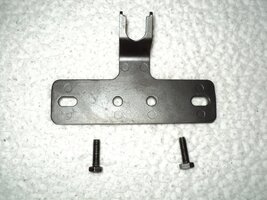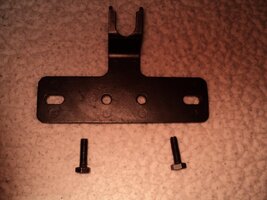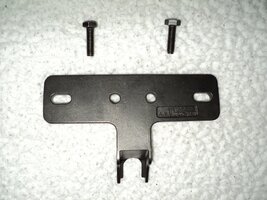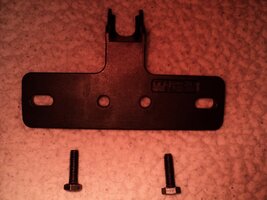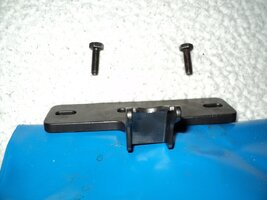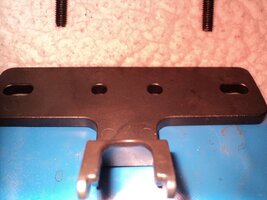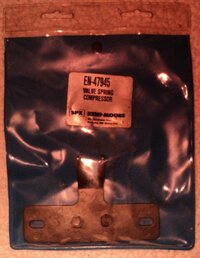Hello all, 2004 Envoy, 225,000Km. A unit my son and my ex picked up without my involvement. It sounds like a diesel, hot or cold like many have reported. I pulled the intake, valve cover and replaced all the lifters.
First I pulled a few and found that they were solid, no springing action at all. One lash adjuster at #1 Intake was like new with 1/8" or so compression motion, the others solid, no movement, I speculate that they are full of crud.
So, I fashioned a simple valve spring "retainer" flat 3-1/2 in wide 1/4 in plate, fasted down at two COP mounts, roll the cam to compress springs, run two bolts down and hold both springs down, roll the cam , take out parts..
I did the process and replaced all with new. Fired it up, clattered like crazy for 20 sec then, back right where it was.
So the theory part. The length of new lash adjusters and the old were within .003 or each other. The new were of course had some movement. I believe that in the engine they were fully extended and then over time crud filled in adjuster and prevented any compressive movement.
What I am theorizing is that due to wear of all valve train part even when a new lash adjuster is installed the lash is too great. Hence the diesel clatter.
The cams and roller don't look too bad but there is some wear.
If I was to pull the lifters back out and put a shim under to take up some of the slack would that be too crazy? The shim I am thinking of will be like a star washer that will allow oil flow down the what I think may be a drain hole at the bottom of the adjuster bore.
I appreciate that this is a quick fix and valve job /rebuilt head would be the way to go but this is my 16 yr old sons and the risk of this vehicle making it through the winter unscathed is low (in my mind), in short I am not putting $3,000 valve job in a $2,000 SUV.
I am also trying to figure out how the lash adjuster work? Are they pressurized through the small hole on the side (as I believe) or does the oil gallery pressurize from the bottom of the adjuster? If it is the latter then my shim theory is a bust. I
have been looking for a drawing of oil galleries and flow but so far can't seem to find.
If the engine oils from the bottom of the lash adjuster (but I don't really think so) then I may have a clogged oil gallery problem.
Advice is appreciated..
L
First I pulled a few and found that they were solid, no springing action at all. One lash adjuster at #1 Intake was like new with 1/8" or so compression motion, the others solid, no movement, I speculate that they are full of crud.
So, I fashioned a simple valve spring "retainer" flat 3-1/2 in wide 1/4 in plate, fasted down at two COP mounts, roll the cam to compress springs, run two bolts down and hold both springs down, roll the cam , take out parts..
I did the process and replaced all with new. Fired it up, clattered like crazy for 20 sec then, back right where it was.
So the theory part. The length of new lash adjusters and the old were within .003 or each other. The new were of course had some movement. I believe that in the engine they were fully extended and then over time crud filled in adjuster and prevented any compressive movement.
What I am theorizing is that due to wear of all valve train part even when a new lash adjuster is installed the lash is too great. Hence the diesel clatter.
The cams and roller don't look too bad but there is some wear.
If I was to pull the lifters back out and put a shim under to take up some of the slack would that be too crazy? The shim I am thinking of will be like a star washer that will allow oil flow down the what I think may be a drain hole at the bottom of the adjuster bore.
I appreciate that this is a quick fix and valve job /rebuilt head would be the way to go but this is my 16 yr old sons and the risk of this vehicle making it through the winter unscathed is low (in my mind), in short I am not putting $3,000 valve job in a $2,000 SUV.
I am also trying to figure out how the lash adjuster work? Are they pressurized through the small hole on the side (as I believe) or does the oil gallery pressurize from the bottom of the adjuster? If it is the latter then my shim theory is a bust. I
have been looking for a drawing of oil galleries and flow but so far can't seem to find.
If the engine oils from the bottom of the lash adjuster (but I don't really think so) then I may have a clogged oil gallery problem.
Advice is appreciated..
L


